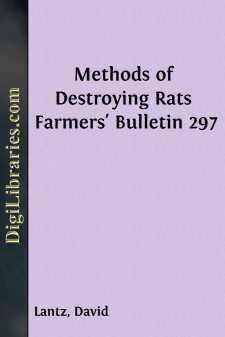Categories
- Antiques & Collectibles 13
- Architecture 36
- Art 48
- Bibles 22
- Biography & Autobiography 813
- Body, Mind & Spirit 142
- Business & Economics 28
- Children's Books 14
- Children's Fiction 11
- Computers 4
- Cooking 94
- Crafts & Hobbies 4
- Drama 346
- Education 46
- Family & Relationships 57
- Fiction 11829
- Games 19
- Gardening 17
- Health & Fitness 34
- History 1377
- House & Home 1
- Humor 147
- Juvenile Fiction 1873
- Juvenile Nonfiction 202
- Language Arts & Disciplines 88
- Law 16
- Literary Collections 686
- Literary Criticism 179
- Mathematics 13
- Medical 41
- Music 40
- Nature 179
- Non-Classifiable 1768
- Performing Arts 7
- Periodicals 1453
- Philosophy 64
- Photography 2
- Poetry 896
- Political Science 203
- Psychology 42
- Reference 154
- Religion 513
- Science 126
- Self-Help 84
- Social Science 81
- Sports & Recreation 34
- Study Aids 3
- Technology & Engineering 59
- Transportation 23
- Travel 463
- True Crime 29
Methods of Destroying Rats Farmers' Bulletin 297
by: David Lantz
Description:
Excerpt
The brown or Norway rat (Mus norvegicus) is the worst mammal pest in the United States, the losses from its depredations amounting to many millions of dollars yearlyâto more, indeed, than the losses from all other injurious mammals combined. In addition to its destructive habits, this rat is now known to be an active agent in disseminating infectious diseases, a fact which renders measures for its destruction doubly important.
Several species of rats are known as "house rats," including the black rat (Mus rattus), the roof rat (Mus alexandrinus), and the brown rat (Mus norvegicus). Of these, the last is the commonest and most widespread in this country. Not one of these species is a native, but all were imported from the Old World. As their habits in general are similar, the instructions given in the bulletin apply alike to all.
Introduced into America about the year 1775, the brown rat has supplanted and nearly exterminated its less robust relative, the black rat, and despite the incessant warfare of man has extended its range and steadily increased in numbers. Its dominance is due to its great fecundity and its ability to adapt itself to all sorts of conditions. It breeds three or four times a year and produces from 6 to 12, and even more, young at a litter. Young females breed when only 4 or 5 months old. The species is practically omnivorous, feeding upon all kinds of animal and vegetable matter. It makes its home in the open field, the hedge row, and the river bank, as well as in stone walls, piers, and all kinds of buildings. It destroys grains when newly planted, while growing, and in the shock, stack, mow, crib, granary, mill, elevator, or ship's hold, and also in the bin and feed trough. It invades store and warehouse and destroys fur, laces, silks, carpets, leather goods, and groceries. It attacks fruits, vegetables, and meats in the markets, and destroys by pollution ten times as much as it actually eats. It carries disease germs from house to house and bubonic plague from city to city. It causes disastrous conflagrations; floods houses by gnawing lead water pipes; ruins artificial ponds and embankments by burrowing; destroys the farmers' pigs, eggs, and young poultry; eats the eggs and young of song and game birds; and damages foundations, floors, doors, and furnishings of dwellings.
METHODS OF DESTROYING RATS.
A compilation of all the methods of destroying rats practiced in historic times would fill a volume. Unfortunately, the greater number of them are worthless or impracticable. Few have more than temporary effect upon their numbers, and even the best of them fail unless persistently applied. Conditions vary so much that no one method of dealing with this pest is applicable in all cases. Among the more important measures to be recommended for actively combating the brown rat are: (1) Poisons; (2) traps; (3) ferrets; (4) fumigation, and (5) rat-proof construction of buildings.
POISONING.
Barium Carbonate.âOne of the cheapest and most effective poisons for rats and mice is barium carbonate, or barytes. This mineral has the advantage of being without taste or smell; and, in the small quantities used in poisoning rats and mice, is harmless to larger animals. Its action on rodents is slow, but reasonably sure, and has the further advantage that the animals before dying, if exit be possible, usually leave the premises in search of water. Its employment in houses, therefore, is rarely followed by the annoying odor which attends the use of the more virulent poisons....


